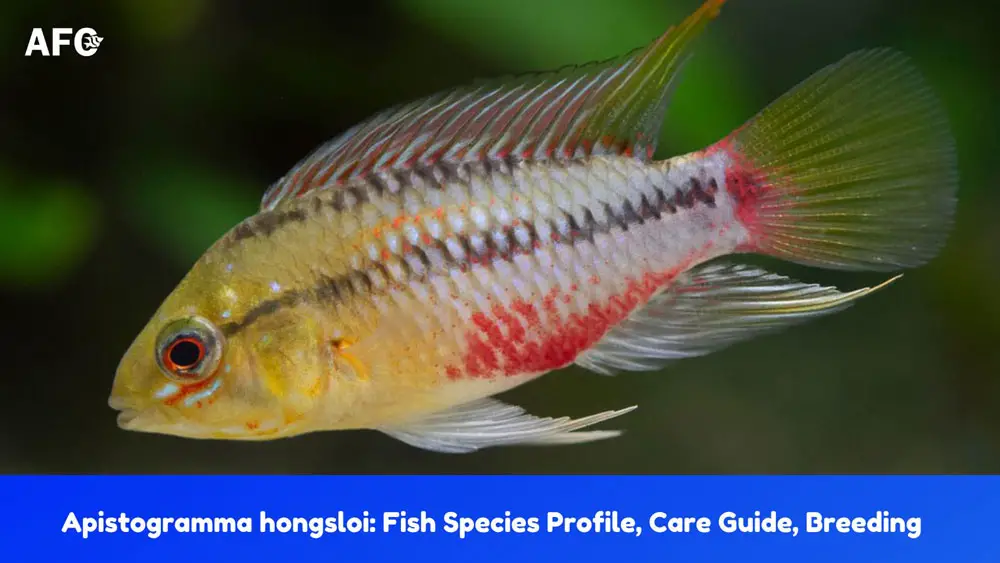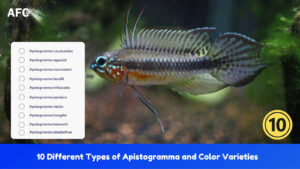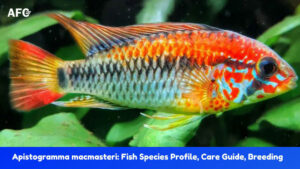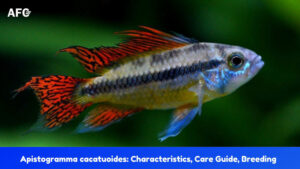Apistogramma hongsloi is a colorful, aggressive dwarf cichlid fish native to the upper and central Orinoco River basin in Colombia and Venezuela.
A. hongsloi are available in several color varieties, such as ‘Red,’ ‘Super Red,’ and ‘Red Gold.’ No matter their color, males and females can be easy to tell apart once they reach sexual maturity.
This medium-sized Apistogramma species is easy to keep in aquariums because virtually all specimens available in the trade are domesticated strains that can tolerate a wide range of water parameters, such as pH, hardness, and temperature.
However, this species is not for first-time Apistogramma owners, given its aggressive nature and the specific water conditions required for successful reproduction.
In this article, you’ll learn the characteristics of Apistogramma hongsloi, how to best care for it, and its reproduction requirements.
What Are the Types of Apistogramma hongsloi?
The most popular color strains of A. hongsloi are as follows.
Apistogramma hongsloi ‘Red’
Apistogramma hongsloi Red, also known as Apistogramma hongsloi red line, is a color variety of wild A. hongsloi from Colombia.
Males have a bright red stripe along the flanks. A red spot is clearly visible at the base of the caudal (or tail) fin, and several more red patches extend downward from the eye, often reaching the edge of the gill cover. The dorsal fin is also splashed with red and edged in yellow.
The red coloration becomes more intense when males are in breeding conditions. Females are less colorful, lacking the red stripes and patches, but they may still display a faint red hue.
Apistogramma hongsloi Form II
A. hongsloi Form II, also referred to as A. hongsloi’ Super Red’, is a man-made color morph selectively bred from multiple forms of A. cf. hongsloi and imported from Germany.
This variant boasts more red color than the standard red variety, which adds to its popularity. In males, the entire body assumes vibrant red color with highlights of silver scales and golden gill cover.
Apistogramma hongsloi ‘Red Gold’
A. hongsloi ‘Red Gold’ is another selectively bred color mutation of A. hongsloi from European breeders.
Male ‘Red Gold’ specimens can be distinguished from the ‘Super Red’ variety by an extensive golden yellow hue on the rear half of their bodies. Furthermore, they exhibit a broader red stripe compared to the standard red form.
How to Tell a Male From a Female Apistogramma hongsloi?
There are a few ways to tell a male from a female Apistogramma hongsloi.
- Check for colors: Males are more colorful than females, with bright red and yellow coloration on their fins and body. Females are mostly grayish-yellow in color. Red is rarely seen in females, even in high-quality German Form II A. hongsloi. When they are ready to spawn, females become bright yellow with black fins.
- Compare the size and dorsal fin: Males are generally larger than females and have more pointed dorsal fins.
- Look at the pelvic fin: Females typically have dark edges on their pelvic fins.
Most of the time, there are no obvious external differences between the young fish smaller than 2 inches (5 cm).
In the wild, their colors and activities are influenced by the seasons. During the dry season, they take on a dark, yellowish-brown color and do not move much, but as the wet seasons come, they become much more active and vibrant as the breeding season gets closer.
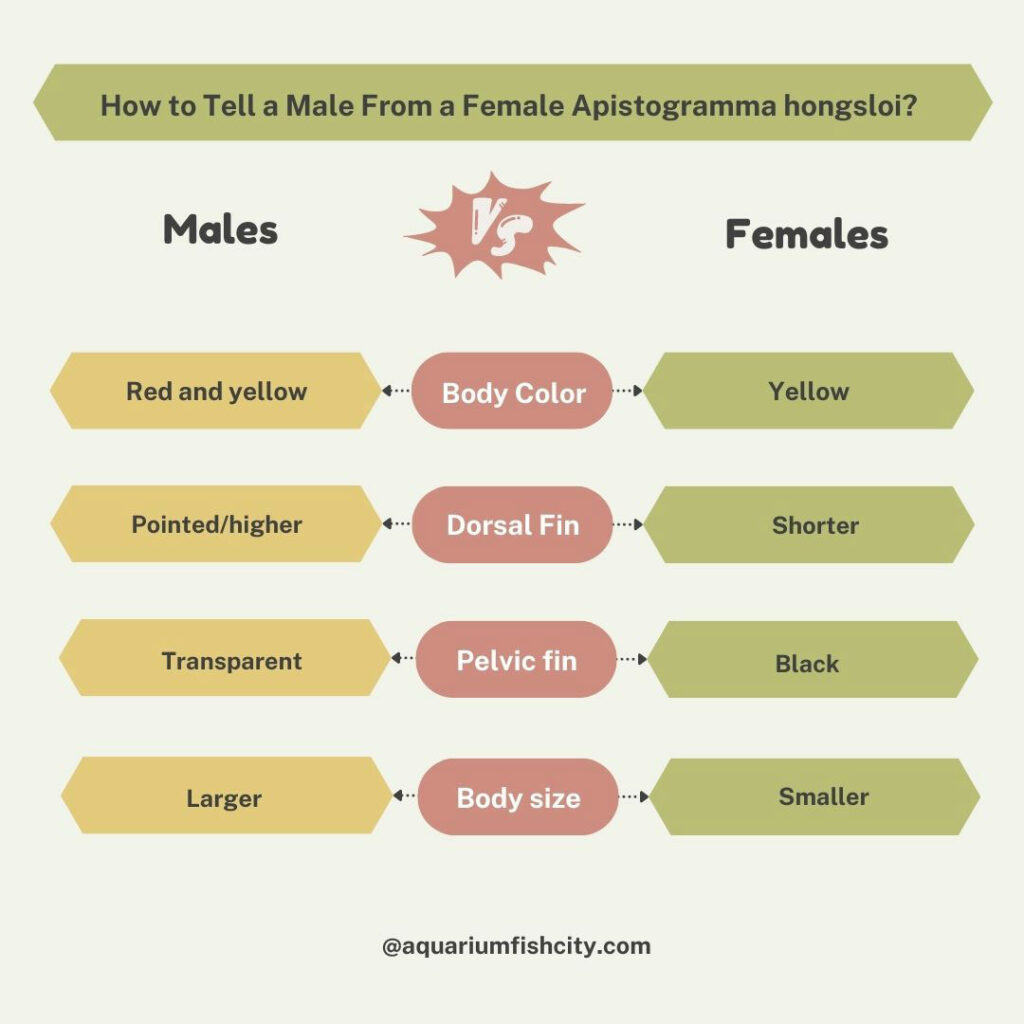
What is The Maximum Size of Apistogramma hongsloi?
The maximum size of Apistogramma hongsloi is 2.8 inches (7 cm) in total length (TL), according to the hardcover book ‘The Most Complete Colored Lexicon of Cichlids: Every Known Cichlid Illustrated in Color’ by Herbert R. Axelrod.
Are Apistogramma hongsloi Aggressive?
Yes, A. hongsloi is known to be an aggressive Apistogramma species. The male has a polygynous mating system, meaning that he will mate with several females in his territory during the breeding season. The male often becomes aggressive towards females who are not ready to spawn.
Apistogramma hongsloi females are highly protective of their eggs and fry. They will attack and chase away any intruder near the spawning site, including the male, other females, and other fish.
Because of their aggressive and territorial nature, it is recommended to keep them in a trio or a harem of one male and several females, depending on the size of your tank.
How Long Do Apistogramma hongsloi Live?
The average lifespan of Apistogramma hongsloi is around two years, but many owners have reported that their fish have lived for up to five years with proper care.
A 1991 statistical study conducted by Dr. Sven O. Kullander on Apistogramma longevity found that the average lifespan of Apistogramma is two years. The study included 7,532 tank-raised specimens from 23 different species, but only 8% survived for more than 24 months.
To help them go beyond average longevity, try to emulate their natural environment as closely as possible in your tank.
What is The Native Habitat of Apistogramma hongsloi?
The native habitat of Apistogramma hongsloi is primarily found in the tropical rainforest areas of the Orinoco River basin, particularly in the vicinity of the Sipapo and Caura Rivers. This environment is characterized by small, slow-moving river banks and shallow streams, as described in Ivan Mikolji’s article “The Natural Habitat of Apistogramma hongsloi.”
The water in their natural habitat is warm, soft, and acidic. Temperatures range from 79 to 82°F (26-28°C), with carbonate hardness (KH) of less than 20 ppm, general hardness (GH) of less than 10 ppm, and a pH level under 5.5.
These fish live at the river bottom, where the substrate consists of white silica sand with diameters ranging from 0.25 to 3mm. The riverbed is often covered with an abundance of leaf litter, aquatic plants, twigs, small branches, and occasionally some driftwood, providing them with ample hiding spots and food sources.
How to Take Care of Apistogramma hongsloi in an Aquarium?
Here are some practical advice and useful tips on how to care for A. hongsloi in the home aquarium.
- Pick the right size aquarium.
- Set up optimal aquarium water parameters.
- Mimic their natural habitat.
- Perform regular water changes.
- Practice routine aquarium maintenance.
- Choose suitable tank mates.
- Feed them a variety of live foods.
Pick the Right Size Aquarium.
The minimum tank size for a trio of Apistogramma hongsloi is 20 gallons (75 liters). If you are keeping a harem of one male and several females, you should give each female a territory of approximately 12 inches (30 cm) in diameter.
Set up Optimal Aquarium Water Parameters
The optimum water parameters for the captive-bred A. hongsloi are as follows.
- pH: 5.5 to 6.0
- Temperature: 79 to 82°F (26-28°C)
- GH: < 5 dGH
- Conductivity: < 100 µS /cm
Tank-raised fish have no problem with moderately hard water and at a neutral pH if you’re keeping fish for fun, but they can be very important if you wish to attempt to breed them and increase their lifespan.
The target pH level and hardness for A. hongsloi can be achieved without adding strong acids. Peat moss will do the job if your tap water is not very hard, or else you should use reverse osmosis (RO) water.
Mimic Their Natural Habitat
Whatever aquarium you go with, the floor should have a sand substrate because Apistogramma are bottom-dwellers and enjoy burrowing in the sand. A few pieces of driftwood, some rocks, and leaf litter will make them feel safe and comfortable.
When selecting live plants for the aquarium, floating species are the best choice for Apistogramma hongsloi. Some good options include Amazon frogbit (Limnobium laevigatum), Anacharis (Egeria densa), or dwarf water lettuce (Pistia stratiotes).
Apistos are cave-dwelling fish, so providing them with hideouts is necessary. Things like clay pots, coconut shells, or other aquarium-safe decorations will work just fine. If you intend to breed, you will need some spawning sites with a “roof” or cave-like structure for the females to lay their eggs in.
Perform Regular Water Changes
Performing frequent water changes of 10-15% weekly is a cardinal rule in maintaining an Apistogramma hongsloi aquarium. The waste buildup, especially in the small tanks, can quickly pollute their water quality. High nitrate and phosphate levels in the water can also contribute to excessive algae growth.
Practice Routine Aquarium Maintenance
Besides performing weekly partial water changes, there are several other essential aquarium maintenance tasks that should be carried out every week or two. Some of the most important ones include:
- Test water parameters to ensure optimal conditions are maintained.
- Change or clean filter media.
- Vacuum the substrate.
- Trim and prune aquatic plants as needed.
- Check for any signs of disease or parasites.
- Clean the tank glass.
- Check for dead or decaying food and remove them.
Keeping a log or journal of all maintenance tasks, test results, and any concerns will allow you to monitor any changes in the aquarium quickly. This record-keeping practice is also an excellent way to track the health and behavior of your fish over time.
Choose Suitable Tank Mates
The suitable tank mates for Apistogramma hongsloi include the following fish.
- Pencilfish: Nannostomus species are a group of small, surface-dwelling schooling fish that are native to South America. These hardy and active fish make great dither fish for A. hongsloi because they can help them feel more comfortable. Pencilfish are also safe for Apistogramma fry.
- Freshwater hatchetfish: These small, top-dwelling nano fish are known for having a hatchet-shaped body and wing-like pectoral fins. They have the tendency to jump out of the aquarium, so it is best to keep them in a lid or covered tank.
- South American tetras: These small schooling fish are peaceful and like to hang out in the upper mid-range of the aquarium. Some popular options include Neon Tetra, Cardinal Tetra, and Ember Tetra. Be aware that tetras will eat Apistogramma fry if given a chance.
- Small South American catfish: These bottom-dwelling fish are native to South America and good companions for Apistogramma hongsloi. Some popular options include Corydoras catfish and Otocinclus catfish. They are active scavengers and can help keep the tank’s bottom clean. If breeding Apistogramma, remove the catfish to protect the fry and egg.
- Freshwater Angelfish: Pterophyllum species can be kept with Apistogramma hongsloi in large community tanks. They will stay in the middle of the tank and not compete for the valuable bottom space taken by Apistos.
Feed Them a Variety of Live Foods
To maintain their good health and vivid coloration, feed them various live foods, such as baby brine shrimp, daphnia, bloodworms, glassworms, and black and white mosquito larvae. These foods are high in nutrients and will help to keep your fish healthy and colorful.
It has been reported that commercially imported Apistogramma hongsloi are usually fed a living food source of cyclops, a tiny crustacean that is rich in color-enhancing pigments. This helps to ensure that their vibrant colors remain intact.
Some individuals may struggle with prepared foods, but this can be resolved by grinding flakes or pellets into a powder and mixing it with frozen or live foods or other things like vitamin supplements. Add hot water and let the mixture solidify into a jello-like consistency for easier consumption.
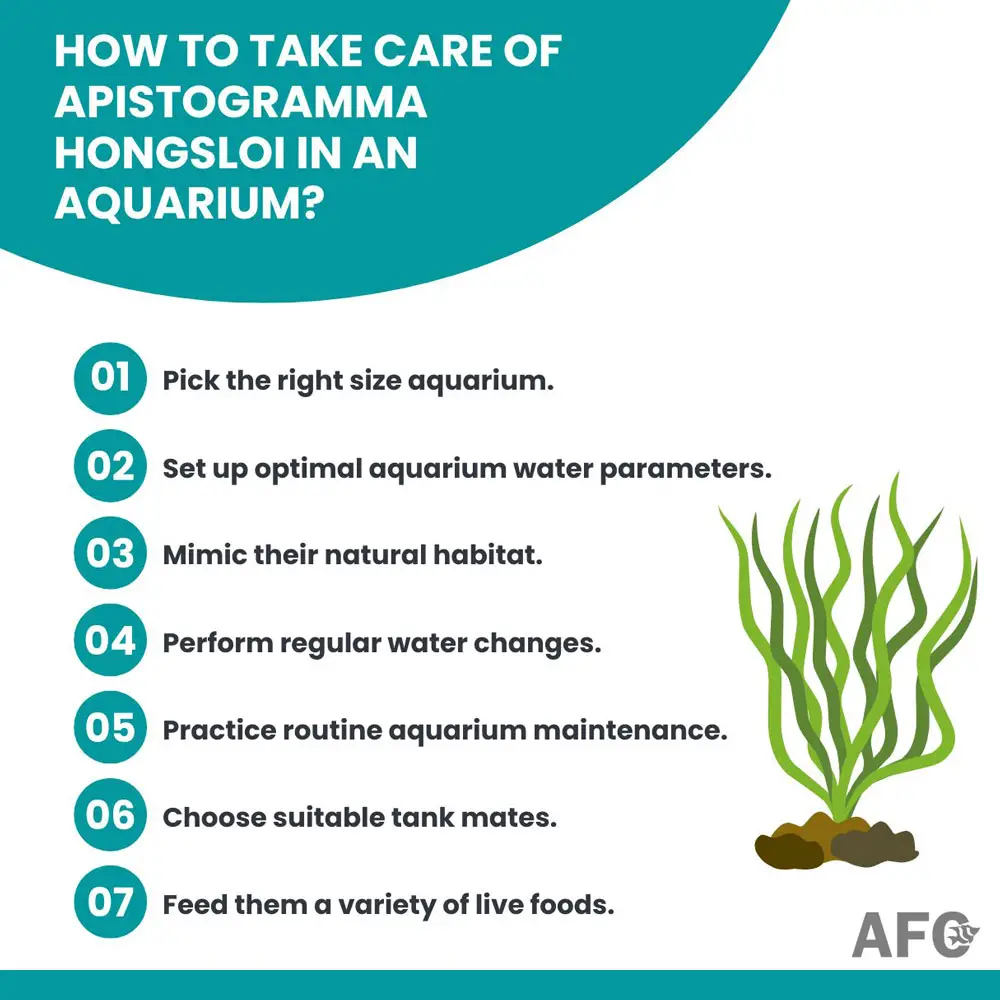
How to Breed Apistogramma hongsloi in The Home Aquarium?
Here is a basic overview of how to breed Apistogramma hongsloi in the home aquarium.
Step 1: Get a breeding pair/trio
You can buy a breeding trio from a professional breeder or purchase at least a half-dozen immature fish and raise them together to establish a breeding group.
Compared to other Apistogramma types that reach sexual maturity at the age of 9 to 10 months, A. hongsloi takes longer, up to 1.5 years or more.
Step 2: Prepare a breeding tank
Prepare a separate breeding tank with a pH of 5.5 to 6, soft water (GH< 5), low TDS of around 50–100 ppm, and an optimum water temperature of 79 to 82°F (26-28°C).
Use a fine sand substrate, and provide plenty of hiding spots with caves made of overturned coconut shells or ceramic pots. Add a small group of pencilfish; dwarf pencilfish (N. marginatus) and brown pencilfish (N. eques) are preferred.
To recreate the desired low-light conditions, add plenty of floating plants and consider covering three sides of the tank with black aquarium backgrounds.
Step 3: Feed them live food
To facilitate spawning, it’s best to condition them with live food prior to breeding.
Step 4: Keep an eye on the behavior
The male may exhibit aggressive behaviors toward the female that is not ready to spawn, and female-to-female aggression may also appear. Keep an eye on the behaviors of your Apistos and provide a refuge for the female accordingly.
Step 5: Observe the spawning behavior
Eventually, a pair will spawn. The female will lay between 60 and 90 eggs on the ceiling of the caves. She then often piles up more sand to block the entrance to the nest, protecting her eggs from predators.
In 2-3 days, the eggs will hatch. After approximately four days, all of the fry will be free swimming near the cave.
You should remove the male because the female is highly protective of fry and will even attack the male if he gets too close.
Step 6: Care for Apistogramma panduro fry
Once the fry are free swimming, they can be fed infusoria and freshly hatched brine shrimp. Perform small water changes of 20% daily to keep the water quality good and promote fry growth.
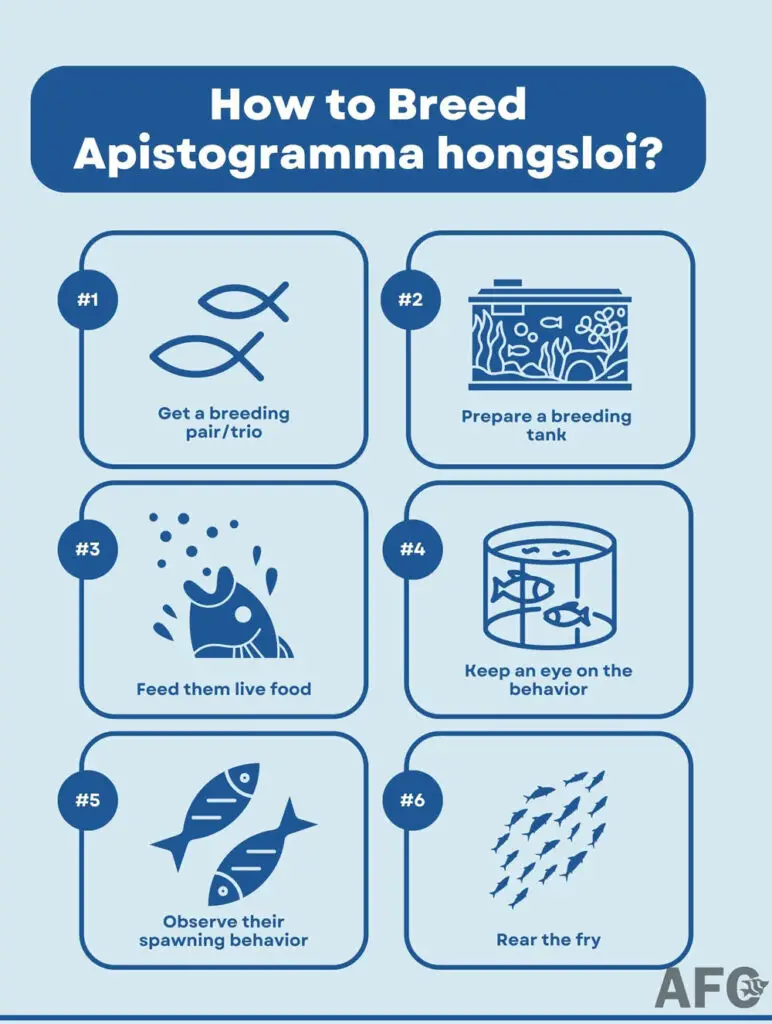
How Much Do Apistogramma hongsloi Cost?
Apistogramma hongsloi are usually sold as a trio, consisting of one male and two females. The price of a trio can range from $50 to $80, depending on whether the fish are captive-bred or wild-caught. Wild-caught specimens are typically more expensive, as they are rarer and more difficult to obtain.
Where to buy Apistogramma hongsloi?
You can buy A. hongsloi from the following sources.
- Aquaticclarity
- TheWetSpotTropicalFish
- AquaticArts
- Dan’s Fish
- Individual breeders on Aquabid and The Band app
